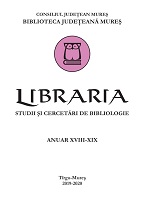Istoria bisericilor şi a vieţii religioase a românilor din Alba Iulia în secolul al XVIII-lea
The History of the Churches and the Religious Life of the Romanians from Alba Iulia in the XVIIIth Century
Author(s): Daniel Nicolae ZotaSubject(s): Christian Theology and Religion, History of Church(es), Social history, 18th Century, Eastern Orthodoxy, History of Religion
Published by: Biblioteca Județeană Mureș
Keywords: Downtown; religious life; Sofronie’s revolt; Maieri; Lipoveni; Orthodox; Greek Catholics. Romanian;
Summary/Abstract: This article aims to shed light on a topic related to the religious life of one of the communities existing in Alba Iulia in the eighteenth century, the Romanian one. The XVIIIth century was tense for the Romanian community, because in the first half it was marked by the union of the Orthodox Church with the Church of Rome (1698-1701), which divided the community into two: Orthodox and United. The second half was marked by anti-union movements initiated by Serbian monks, including Sofronie from Cioara, who arrived in Alba Iulia in 1761, but the revolt was defeated by General Buccow. In addition to doctrinal issues, the urban works initiated by the Austrian authorities in the context of the construction of the large Vauban-type fortress, after which the neighborhoods around the fortress were demolished and the population was moved to the eastern part of Alba Iulia, a swampy land, unfavorable for construction. In the fortress was the cathedral of the Orthodox Metropolitan Church of Transylvania, which functioned here in the XVI-XVIII centuries, and its destruction scandalized the Romanian public opinion, well-known names such as Timotei Cipariu or George Bariţiu criticized this action, but also the way the church representatives led by Ştefanovici, the typographer and the epitropus used the money (1300 florins) for the construction of a new place of worship in the Maierii Bălgradului. During the eighteenth century, the Romanians built four churches over a fairly long period of time, so in the period 1714-1720, the Greek Catholic Romanians in Maieri built a small church without a tower, but with the help of wealthier citizens, Andrei Boier and Bucur Spinare, continued the construction works. After 1754, the first Romanian school in Alba Iulia functioned near the church, and after 1762, with the consent of Empress Maria Theresa, he built a building to serve the school and the parish, the current parish house. In 1720, the Romanians brought from Lipova Arad to build the fortress, received a settlement in the northeastern extremity of the city, where they built houses and with the help of rich merchants, Ioan Dragoş de Thurma or Dragoş Ivan built the church „Assumption of the Blessed Virgin Mary,” an important religious monument of Baroque architecture and where the synod convened by Sofronie took place in February 1761. In the period after Sofronie's revolt, the Romanian Orthodox in these neighborhoods tried to lead their religious life in makeshift places, the lawyer Rubin Patiţia confesses that the divine services took place in a wooden household annex. After 1766, with the financial contribution of some Greek merchants led by Manu and Kriska Karandoni, they managed to build a wall church for the Romanian community in the Lipoveni neighborhood, adorned with icons and expensive objects, donated by members of this family, to which is added contribution to Ioan Apolzan, Ioan Afulea and Stoian Chiţul. In 1794, the construction of the church was completed and was dedicated to the „Annunciation.” In the last years of the century, the Romanian Orthodox in Maieri initiated the construction of a stone place of worship instead of a wooden one, mentioned in the documents from the parish archive. The construction took place between 1795-1797 under the leadership of the parish priests Nicolae Rusan and Nicolae Georgevici, and for the execution of the painting they called Simon Silaghi, master who also made the mural of the church „Buna Vestire” and who was given a house near the church. The religious life of the Romanians from Alba Iulia represents a small part of the beautiful and rich history of the city on the banks of the Mureş, a community that, although divided by the union with the Church of Rome, left behind the important broom of its presence, the four churches mentioned. but also this interesting information that comes to light and allows us to understand how the life of some communities unfolded 300 years ago. Promoting the history of the Downtown is beneficial, because, along with the Alba Carolina Fortress, it presents very interesting information and an important built heritage, completing together the cultural and historical dowry of Alba Iulia.
Journal: Libraria. Studii și cercetări de bibliologie
- Issue Year: XIX/2020
- Issue No: 18-19
- Page Range: 195-222
- Page Count: 28
- Language: Romanian

